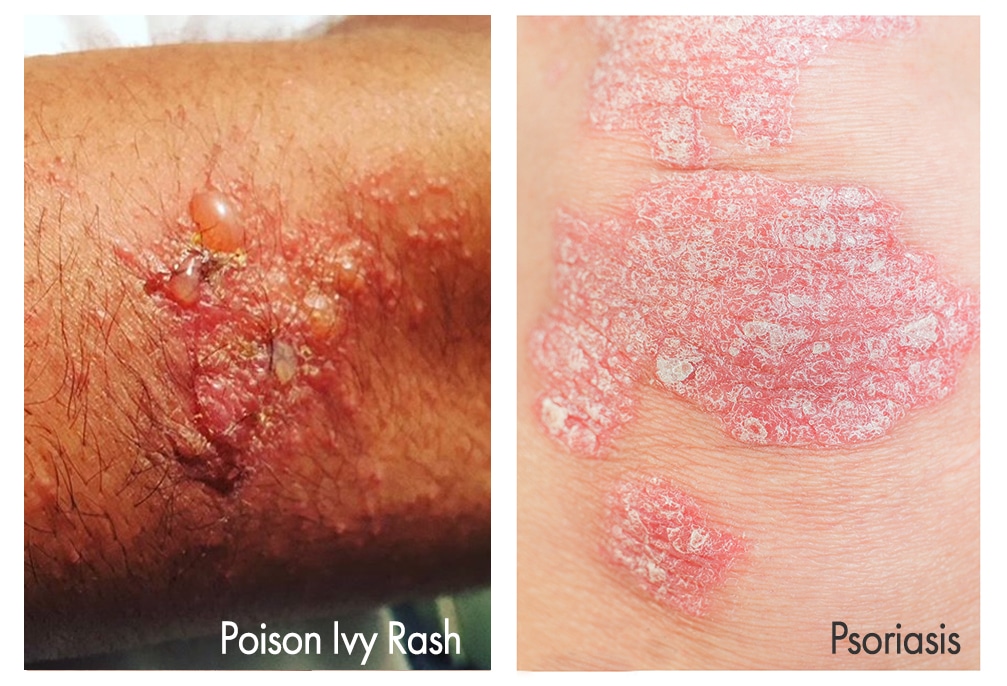Psoriasis vs. Poison Ivy Rash: How to Differentiate them

Trying to determine whether you have poison ivy rash or psoriasis? Can't tell them apart? You're not alone. Most people do not know how to differentiate between poison ivy and psoriasis. Both are skin conditions that produce rash-like symptoms. However, it is essential to know the difference between the two skin conditions because they are caused by different issues and require different treatments.
Being unsure of how to treat poison ivy and psoriasis means you are more likely to keep scratching, irritating the area, and prolonging your suffering. To avoid that, here are some significant differences between poison ivy and psoriasis so you can avoid getting them mixed up.
What is Poison Ivy Rash?
Poison ivy rash is an immune response to urushiol. Urushiol is a sticky resin that coats the leaves, stems, roots, and berries of poison ivy and similar plants.
The rash is not contagious, but it can spread on your skin if you touch it. The rash from poison ivy looks different depending on how long it has been since you came into contact with the plant. A few hours after exposure, you might notice small red bumps, which can turn into blisters later. The rash usually lasts for about two to three weeks if left untreated. It will eventually heal on its own, although it can be uncomfortable in the meantime.
What is Psoriasis?
Psoriasis is an immune-mediated disease affecting over 7 million Americans. It results from the rapid growth of skin cells. There are five types of psoriasis: plaque, guttate, inverse, pustular, and erythrodermic. This hypersensitivity causes the body to produce new skin cells at an increased rate, resulting in thickened, inflamed, and sometimes leathery skin patches.
The severity of psoriasis varies widely from patient to patient. Some may experience mild discomfort while others find their lives completely disrupted by the condition; in the most extreme cases, the lesions may cause bleeding and permanent scarring.
Psoriasis vs. Poison Ivy Rash: Symptoms
Suppose you can identify the symptoms of poison ivy and psoriasis before they appear on your body. In that case, you should be able to properly treat your condition so that you are not left with an infection that is much worse than if you had not left it untreated.
Poison ivy rash
Poison Ivy rash looks similar to psoriasis in that it is a red itchy rash. Poison ivy rash can be found anywhere on the body and doesn't have any specific pattern. The symptoms usually develop within 12 hours of contact with poison ivy. The rash is a red or pink bump that turns into a blister with a white center. The bump becomes a scaly patch within a few days and clears up in 2-3 weeks.
Psoriasis
Psoriasis appears as thick white or silvery patches or plaques on the skin. Psoriasis can be in various colors, from pink to brown to red. The condition usually begins with a single rash on one part of the body before spreading across other areas. Like poison ivy, psoriasis causes itchy and painful bumps that form blisters before turning into scaly patches with silvery scales.
Psoriasis vs. Poison Ivy Rash: Treatment
Poison ivy and psoriasis are both itchy skin diseases. The treatment is often where you run into issues because poison ivy and psoriasis have different causes, so they also have different treatments.
Poison ivy rash
There's nothing like the first warm days of spring to get you out in the garden and bring along the risk of getting an itchy rash from poison ivy. While these symptoms can be very uncomfortable, the good news is that there are ways to treat your rash and soothe your itching.
- Wash your skin as soon as possible with Tecnu Original Outdoor Skin Cleanser or Tecnu Extreme Poison Ivy Scrub to remove the invisible oil that causes the rash. The sooner you wash the oil off your skin after exposure, the better.
Tecnu helps rid your skin of this toxin, which reduces the severity and duration of your rash. - If you develop a rash, use an OTC anti-itch medication for itch relief until the rash has healed (usually 7 to 10 days). Before bedtime, using these products will help you sleep through the night without itching.
Prevent poison ivy rash
Prevention is the best treatment for poison ivy rash. Suppose you're a person who loves the outdoors or mainly works in forested areas. In that case, you're more likely to encounter poison ivy or related plants. As preventive measures, always be prepared to prevent the spreading of poison ivy.
Psoriasis
The first thing to do is visit a dermatologist. Psoriasis can lead to more severe infections and joint problems when left untreated.
If you have psoriasis, you know it can be a lifelong journey to find the proper treatment—or combination of treatments. It's important to remember that there is no cure for psoriasis. Still, many things can be done to control or minimize your symptoms. There are various treatment options available, including topical applications, phototherapy, and systemic medications.
Conclusion
When it comes to rashes, the issue is usually finding ways to differentiate them so that you can know what kind of rash you have. While both are uncomfortable and often itchy, there are a few differences between poison ivy and psoriasis rashes. Some rashes look like others, and many different things can cause them, so the first step in knowing what you're dealing with is often knowing how to differentiate them.




